英文翻译
- 格式:doc
- 大小:498.50 KB
- 文档页数:40
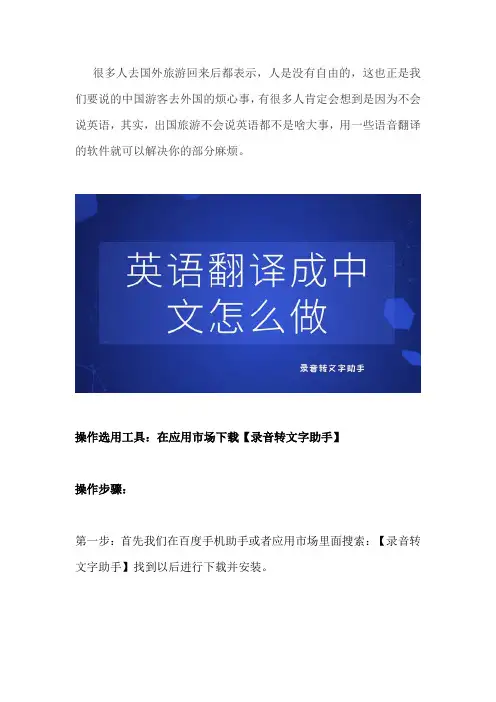
很多人去国外旅游回来后都表示,人是没有自由的,这也正是我们要说的中国游客去外国的烦心事,有很多人肯定会想到是因为不会说英语,其实,出国旅游不会说英语都不是啥大事,用一些语音翻译的软件就可以解决你的部分麻烦。
操作选用工具:在应用市场下载【录音转文字助手】
操作步骤:
第一步:首先我们在百度手机助手或者应用市场里面搜索:【录音转文字助手】找到以后进行下载并安装。
第二步:接着打开软件就可以看到【录音识别】、【文件识别】、【语音翻译】、【录音机】的四个功能,这里我们就举例说明下【语音翻译】。
第三步:点击橙色的【中文】按钮,开始说中文以后,下面就是翻译的英文。
第四步:点击蓝色的【English】按钮,开始说英文,就可以把你说的英语转成中文了。
以上方法就可以做语音翻译了,如果你也需要的话,可以操作起来咯。

Although you spent your previous time without me, I can not live the rest of my life without you——你的过去,我来不及参与;但你的未来,一定要有我。
Although you spent your previous time without me, I can not live the rest of my life without you——你的过去,我来不及参与;但你的未来,一定要有我。
Love is not about how much you say "I love you", but how much you can prove that it's true. /爱情不在于说多少次“我爱你”,而在于怎么样去证明你说的是真的I'd rather love someone I can't have than have someone I can't Love——我宁愿爱上一个我不能拥有的人,也不想拥有一个我无法爱上的人Your life only lasts for a few decades, so be sure that you don\'t leave any regrets. Laugh or cry as you like, and it…s meaningless to oppress yourself. 人生短短几十年,不要给自己留下了什么遗憾,想笑就笑,想哭就哭,该爱的时候就去爱,无谓压抑自己。
Life consists not in holding good cards but in playing those you hold well. 生活不在于你有一副好牌,而在于你如何打好手上的这副牌。
I always have this fear that one day you are going to discover that I\'m not as great as you once thought I was. 我总是害怕,有一天你会发现,我没你想的那么好。
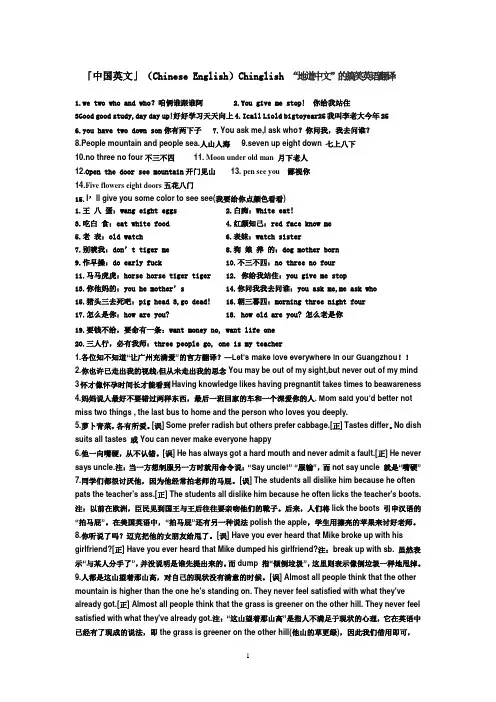
「中国英文」(Chinese English)Chinglish “地道中文”的搞笑英语翻译1.we two who and who?咱俩谁跟谁阿2.You give me stop! 你给我站住3Good good study,day day up!好好学习天天向上4.Icall Liold bigtoyear25我叫李老大今年256.you have two down son你有两下子7.You ask me,I ask who?你问我,我去问谁?8.People mountain and people sea.人山人海9.seven up eight down 七上八下10.no three no four不三不四11. Moon under old man 月下老人12.Open the door see mountain开门见山13. pen see you鄙视你14.Five flowers eight doors五花八门15.I’ll give you some color to see see(我要给你点颜色看看)1.王八蛋:wang eight eggs2.白痴:White eat!3.吃白食:eat white food4.红颜知己:red face know me5.老表:old watch6.表妹:watch sister7.别唬我:don’t tiger me 8.狗娘养的:dog mother born9.作早操:do early fuck 10.不三不四:no three no four11.马马虎虎:horse horse tiger tiger 12. 你给我站住:you give me stop13.你他妈的:you he mother’s 14.你问我我去问谁:you ask me,me ask who15.猪头三去死吧:pig head 3,go dead! 16.朝三暮四:morning three night four17.怎么是你:how are you? 18. how old are you? 怎么老是你19.要钱不给,要命有一条:want money no, want life one20.三人行,必有我师:three people go, one is my teacher1.各位知不知道“让广州充满爱”的官方翻译?—Let’s make love everywhere in our Guangzhou!!2.你也许已走出我的视线,但从未走出我的思念You may be out of my sight,but never out of my mind 3怀才像怀孕时间长才能看到Having knowledge likes having pregnantit takes times to beawareness 4.妈妈说人最好不要错过两样东西,最后一班回家的车和一个深爱你的人. Mom said you’d better not miss two things , the last bus to home and the person who loves you deeply.5.萝卜青菜,各有所爱。

英语怎么翻译成中文,怎么翻译英语语音,现在在大街上遇到外国友人的几率已经越来越高了,但苦于自己不会英语不能与他们畅谈一番,网上的确有很多翻译器但是总不能交流的时候还带着个电脑听他们讲话吧,有没有手机上可以直接将英语语音翻译成中文文字的呢!
操作一:首先拿出自己随身带的手机,在软件商店内搜索“语音翻译器”进行下载。
操作二:将APP软件下载至手机内后,我们将其打开并设置其源语言以及目标语言。
(今天我们讲的是英文翻译成中文,所以以下图
片也是按照这个来的哦)
操作三:设置完成我们需要翻译的语言后,点击APP的左下角的源语言,对着手机讲出需要翻译的内容。
操作四:讲完需要翻译的内容后,再点击一下刚才的位置(完成的选项按钮)。
操作五:翻译完成后,页面内会出现翻译的内容,大家可以对其进行“编辑,复制,全屏,收藏,分享,删除”等操作。
操作六:APP的左上方还可以设置“收藏夹,语速调节”等功能哦,可以在翻译完成后做个简单的了解。
好了,这样一来英语语音就可以翻译成中文啦,遇到外国友人交流的时候掏出手机,耐心等待他们说完然后就可以根据翻译回答他们啦。
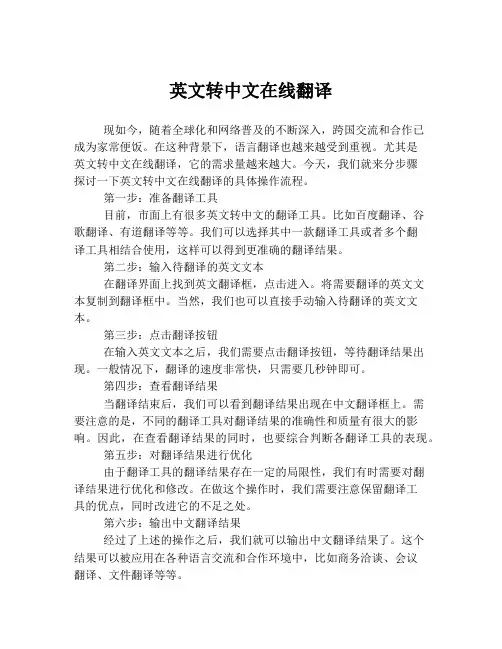
英文转中文在线翻译现如今,随着全球化和网络普及的不断深入,跨国交流和合作已成为家常便饭。
在这种背景下,语言翻译也越来越受到重视。
尤其是英文转中文在线翻译,它的需求量越来越大。
今天,我们就来分步骤探讨一下英文转中文在线翻译的具体操作流程。
第一步:准备翻译工具目前,市面上有很多英文转中文的翻译工具。
比如百度翻译、谷歌翻译、有道翻译等等。
我们可以选择其中一款翻译工具或者多个翻译工具相结合使用,这样可以得到更准确的翻译结果。
第二步:输入待翻译的英文文本在翻译界面上找到英文翻译框,点击进入。
将需要翻译的英文文本复制到翻译框中。
当然,我们也可以直接手动输入待翻译的英文文本。
第三步:点击翻译按钮在输入英文文本之后,我们需要点击翻译按钮,等待翻译结果出现。
一般情况下,翻译的速度非常快,只需要几秒钟即可。
第四步:查看翻译结果当翻译结束后,我们可以看到翻译结果出现在中文翻译框上。
需要注意的是,不同的翻译工具对翻译结果的准确性和质量有很大的影响。
因此,在查看翻译结果的同时,也要综合判断各翻译工具的表现。
第五步:对翻译结果进行优化由于翻译工具的翻译结果存在一定的局限性,我们有时需要对翻译结果进行优化和修改。
在做这个操作时,我们需要注意保留翻译工具的优点,同时改进它的不足之处。
第六步:输出中文翻译结果经过了上述的操作之后,我们就可以输出中文翻译结果了。
这个结果可以被应用在各种语言交流和合作环境中,比如商务洽谈、会议翻译、文件翻译等等。
总的来说,英文转中文在线翻译已经成为我们日常生活中不可替代的一部分。
通过采用多种翻译工具相结合的方式,我们可以得到更准确而且优秀的翻译结果,进一步促进国际合作和交流的发展。
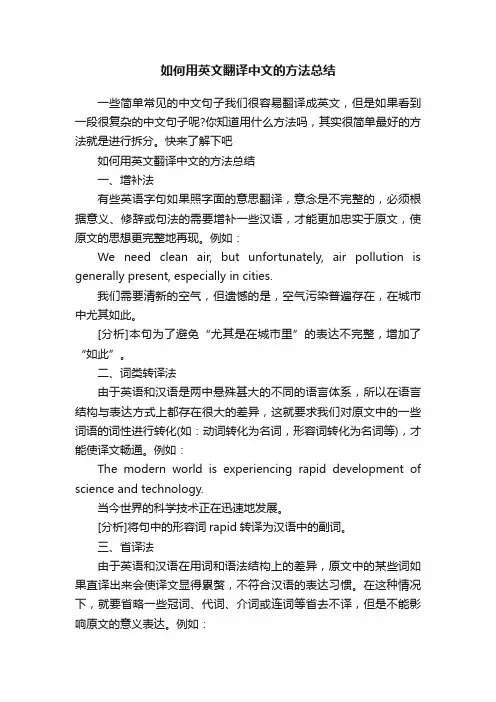
如何用英文翻译中文的方法总结一些简单常见的中文句子我们很容易翻译成英文,但是如果看到一段很复杂的中文句子呢?你知道用什么方法吗,其实很简单最好的方法就是进行拆分。
快来了解下吧如何用英文翻译中文的方法总结一、增补法有些英语字句如果照字面的意思翻译,意念是不完整的,必须根据意义、修辞或句法的需要增补一些汉语,才能更加忠实于原文,使原文的思想更完整地再现。
例如:We need clean air, but unfortunately, air pollution is generally present, especially in cities.我们需要清新的空气,但遗憾的是,空气污染普遍存在,在城市中尤其如此。
[分析]本句为了避免“尤其是在城市里”的表达不完整,增加了“如此”。
二、词类转译法由于英语和汉语是两中悬殊甚大的不同的语言体系,所以在语言结构与表达方式上都存在很大的差异,这就要求我们对原文中的一些词语的词性进行转化(如:动词转化为名词,形容词转化为名词等),才能使译文畅通。
例如:The modern world is experiencing rapid development of science and technology.当今世界的科学技术正在迅速地发展。
[分析]将句中的形容词rapid转译为汉语中的副词。
三、省译法由于英语和汉语在用词和语法结构上的差异,原文中的某些词如果直译出来会使译文显得累赘,不符合汉语的表达习惯。
在这种情况下,就要省略一些冠词、代词、介词或连词等省去不译,但是不能影响原文的意义表达。
例如:There was no snow, the leaves were gone from the trees, the grass was dead.天未下雪,但叶落草枯。
[分析]在汉语中“叶落”的概念非常清楚,所以省译了from the trees.四、顺译法也就是说按照英语表达的层次顺序,依次翻译英语句子,从而使译文与英语原文的顺序基本一致。
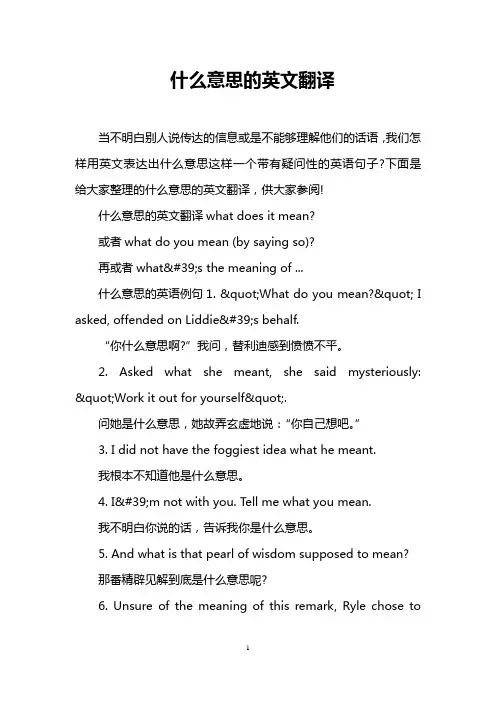
什么意思的英文翻译当不明白别人说传达的信息或是不能够理解他们的话语,我们怎样用英文表达出什么意思这样一个带有疑问性的英语句子?下面是给大家整理的什么意思的英文翻译,供大家参阅!什么意思的英文翻译what does it mean?或者what do you mean (by saying so)?再或者what's the meaning of ...什么意思的英语例句1. "What do you mean?" I asked, offended on Liddie's behalf.“你什么意思啊?”我问,替利迪感到愤愤不平。
2. Asked what she meant, she said mysteriously: "Work it out for yourself".问她是什么意思,她故弄玄虚地说:“你自己想吧。
”3. I did not have the foggiest idea what he meant.我根本不知道他是什么意思。
4. I'm not with you. Tell me what you mean.我不明白你说的话,告诉我你是什么意思。
5. And what is that pearl of wisdom supposed to mean?那番精辟见解到底是什么意思呢?6. Unsure of the meaning of this remark, Ryle chose toremain silent.由于不确定这句话究竟是什么意思,赖尔选择了保持沉默。
7. And what, we may ask parenthetically, does it mean?我们想顺带问一句,这是什么意思?8. "You're unbelievably lucky."; 'What do you mean by that.'“你真是太幸运了。
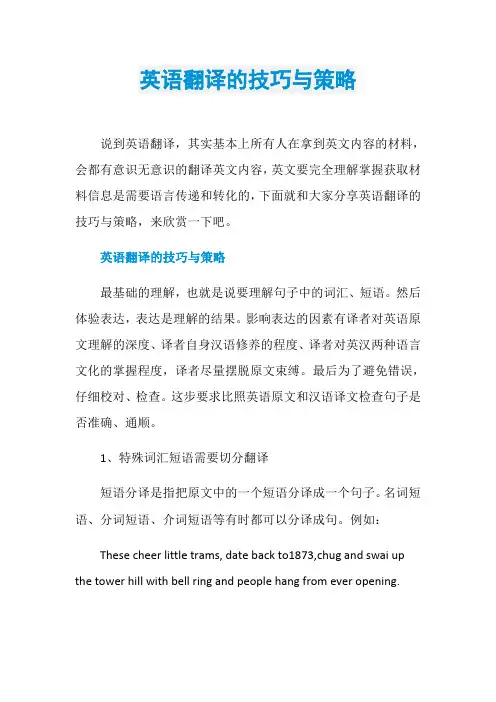
英语翻译的技巧与策略说到英语翻译,其实基本上所有人在拿到英文内容的材料,会都有意识无意识的翻译英文内容,英文要完全理解掌握获取材料信息是需要语言传递和转化的,下面就和大家分享英语翻译的技巧与策略,来欣赏一下吧。
英语翻译的技巧与策略最基础的理解,也就是说要理解句子中的词汇、短语。
然后体验表达,表达是理解的结果。
影响表达的因素有译者对英语原文理解的深度、译者自身汉语修养的程度、译者对英汉两种语言文化的掌握程度,译者尽量摆脱原文束缚。
最后为了避免错误,仔细校对、检查。
这步要求比照英语原文和汉语译文检查句子是否准确、通顺。
1、特殊词汇短语需要切分翻译短语分译是指把原文中的一个短语分译成一个句子。
名词短语、分词短语、介词短语等有时都可以分译成句。
例如:These cheer little trams, date back to1873,chug and swai up the tower hill with bell ring and people hang from ever opening.这些令人欢快的小缆车建于1873年,嘎嚓嘎嚓摇摆爬上高耸的山峦。
车上铃儿叮当作响,每个窗口都是人。
介词短语分译)2、语言顺序特殊的调整句式顺序法词序调整法的英语inversion一词,不能译成“倒译”、“倒译法”或“颠倒词序”之类,否则容易和语法中的“倒装”概念相混淆。
inversion作为一种翻译技巧,其意思为:翻译时对词序作必要或必不可少的改变,并不只是纯粹的颠倒词序或倒装。
Americans do not like to be called materialistic because they feel that this unfairly accuses them of loving only material things and of having no religious values.美国人不喜欢被称为物质主义者, 因为他们认为指控他们只重物质利益, 没有宗教价值观是不公正的。
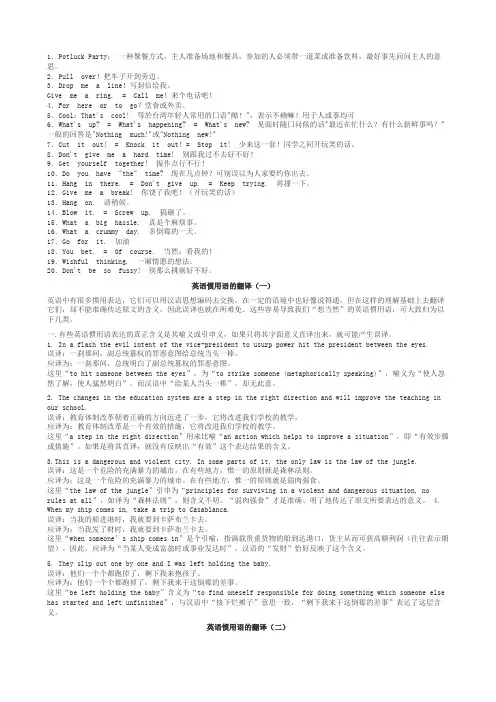
1.Potluck Party:一种聚餐方式,主人准备场地和餐具,参加的人必须带一道菜或准备饮料,最好事先问问主人的意思。
2.Pull over!把车子开到旁边。
3.Drop me a line!写封信给我。
Give me a ring. = Call me!来个电话吧!4.For here or to go?堂食或外卖。
5.Cool:That's cool! 等於台湾年轻人常用的囗语"酷!",表示不赖嘛!用于人或事均可6.What's up? = What's happening? = What's new? 见面时随囗问候的话"最近在忙什么?有什么新鲜事吗?"一般的回答是"Nothing much!"或"Nothing new!"7.Cut it out! = Knock it out!= Stop it! 少来这一套!同学之间开玩笑的话。
8.Don't give me a hard time! 别跟我过不去好不好!9.Get yourself together! 振作点行不行!10.Do you have "the" time? 现在几点钟?可别误以为人家要约你出去。
11.Hang in there. = Don't give up. = Keep trying. 再撑一下。
12.Give me a break! 你饶了我吧!(开玩笑的话)13.Hang on. 请稍候。
14.Blow it. = Screw up. 搞砸了。
15.What a big hassle. 真是个麻烦事。
16.What a crummy day. 多倒霉的一天。
17.Go for it. 加油18.You bet. = Of course. 当然;看我的!19.Wishful thinking. 一厢情愿的想法。

在学习不同的语言时,我们可能会无法确认我们翻译的是否都是正确的,所以我们需要进行在线翻译,将英语翻译成中文,下面就让小编给大家简单介绍一下。
步骤一:将英文翻译成中文的方法是可以直接进入到一点翻译网站中进行翻译的;
步骤二:进入之后就可以找到短句在线翻译,然后点击开始翻译进入;
步骤三:进入之后就可以将需要翻译的语言进行设置了,点击下拉框选择英文翻译中文;
步骤四:之后就可以将英文短句放在左侧的矩形框中,然后点击开始压缩;
步骤五:压缩是需要一定的时间的,我们可以耐心的等待一段时间,短句翻译完成;
步骤六:短句翻译完成之后就可以看到右侧矩形框中会有翻译成功的中文。
以上就是小编给大家简单介绍的在线翻译的方法,希望可以帮助到大家。

你说出来,就能翻译出来。
你说中文,就翻译成英文,你说英文,就翻译成中文,今天就给大家介绍一下这个非常有意思的一个功能。
操作选用工具:在应用市场下载【录音转文字助手】
操作步骤:
第一步:首先我们在百度手机助手或者应用市场里面搜索:【录音转文字助手】找到以后进行下载并安装。
第二步:接着打开软件就可以看到【录音识别】、【文件识别】、【语音翻译】、【录音机】的四个功能,这里我们就举例说明下【语音翻译】。
第三步:点击橙色的【中文】按钮,开始说中文以后,下面就是翻译的英文。
第四步:点击蓝色的【English】按钮,开始说英文,就可以把你说的英语转成中文了。
以上就是语音翻译的操作步骤了,是不是很简单呢,记得去下载使用哦。
英语转换中文在线翻译
英语转换中文在线翻译是一种非常便捷而实用的工具,能够帮助我们快速地将英文内容转化为中文,以便更好地理解、使用。
下面将分步骤介绍英语转换中文在线翻译的使用方法:
第一步:打开翻译网站。
在浏览器中输入“英语转换中文在线翻译”等相关关键词搜索,会出现多个在线翻译网站的链接。
选择一个你熟悉或信任的网站,在搜索框中输入所需翻译的英文内容。
第二步:选择翻译语言。
在翻译框中,通常默认为英文到中文的翻译,如果需要翻译其他语言,可以点击下拉菜单,选择相应的翻译语言,并输入需要翻译的文本。
第三步:确认翻译结果。
翻译完成后,网站会自动将翻译后的中文文本呈现在翻译框中。
确认翻译结果是否准确,如果出现翻译不准确的情况,可以手动修改。
第四步:复制粘贴。
如果需要将翻译文本放在其他地方使用,例如你的电子邮件、文章、研究论文等,可以将翻译文本复制到剪贴板中,然后粘贴到目标位置即可。
需要注意的是,虽然在线翻译软件可以帮助我们快速翻译文本,但是它并不是完美的,还需要我们自己进行合理的修订和校对,以确保所翻译内容的准确性和流畅性。
此外,在使用在线翻译网站的时候,一定要注意使用安全。
不要轻易在未知的网站泄露个人隐私信息,例如邮箱地址、电话号码等。
在使用之前,可以查看网站的隐私政策和服务条款,以确保自己的信息安全。
总之,英语转换中文在线翻译是一个非常方便、实用的工具,适用于各种情况下的翻译需求。
通过遵循上述步骤,并注意安全使用,我们可以在英汉翻译中获得更加高效的帮助。
制作:蔡火祥 08-08-2012制作:蔡火祥 08-08-2012制作:蔡火祥 08-08-2012中文与英文翻译制作:蔡火祥 08-08-2012制作:蔡火祥 08-08-2012制作:蔡火祥 08-08-2012ESE OR ENGLISH TRANSLATION 中文与英文翻译制作:蔡火祥 08-08-2012制作:蔡火祥 08-08-2012常用词汇中英文对照序号英文中文序号英文中文序号英文中文1DENON天龙40POWER BUTTON开关键2MARANTZ马兰士41CARD CABLE软排线3PIONEER先锋42CUSHION SNOW保丽龙4NEW MODEL新机型43WASHER垫片5FRONT PANEL外面的面壳44GREASE润滑油6INNER PANEL里面的面壳45FELT绒布7MAIN CHASSIS底壳 底板46BRACKET支架8CD MECHA机芯47HEAT SINK散热器9BACK CHASSIS后板 后盖48WIRE线材10TOP COVER上盖 顶盖49BUSHING后板用的塞子11AC CORD电源线50PLATE接地片12LABEL贴纸51MAC ADDRESS MAC地址13PACKING包装52CODE物料编码14DISPLAY WINDOW镜片53SILVER银色15SCREW螺丝54BLACK黑色16BADGE铭牌55BONDING打胶处理17DOOR卡门56LUG WIRE地线18CABLE TIE扎带57RUNNINGCHANGE原来的使用完之后自动变更为新的 但不能乱用19CLAMP MTG锁螺丝的扎带20NUT螺母58SPERKER音箱21KNOB旋钮59SUB WOOFER低音炮22FOOT机脚60DOUBLE TAPE双面胶23FOOT CUSHION机脚下的垫子61TAPE胶带24SUPPORT PCB PCB支架6225TRANS变压器6326ACETATE TAPE布织布6427FM ANTENNA FM天线6528AM ANTENNA AM天线6629BATTERY电池6730POLY BAG包装袋6831MANUAL说明书6932WARRANTY CARD保证卡7033SERIAL NO.序列号7134REMOCON遥控器7235BOX GIFT彩箱7336CARTON纸箱7437SHEET卡片7538HOLE孔 洞7639LENS灯罩77。
翻译的英文单词是什么关于翻译的英文单词是什么翻译的作用是把一种语言转换为另外一种语言,那么有哪些英文单词是可以表示翻译的呢?店铺为大家精心准备了表达翻译的几个英文单词,欢迎大家前来阅读。
翻译的'英文单词:interpret英 [nt:prt] 美 [nt:rprt]及物动词解释; 理解; 口译; 诠释,体现不及物动词作解释; 作口译及物动词1. We interpret a frown as a sign of disapproval.我们把皱眉当作不赞成的表示。
2. Not everybody agreed with the way she interpreted the violin concerto, but it was still a technically perfect performance.并非每人都同意她对那首小提琴协奏曲的诠释,但是她的演奏在技巧上仍是无懈可击。
3. I interpret his answer as a refusal.我把他的回答理解为拒绝。
4. We interpreted his silence as a refusal.我们认为他的沉默就是拒绝。
不及物动词1. Would you like me to interpret for you?我给你当翻译好吗?翻译的英文:translate英 [trnslet] 美 [trnslet, trnz-, trnslet, trnz-]1. If you inconvenience, I apologize for how to translate into English...如果对你造成不便,我深感抱歉怎样翻译成英语。
2. Phil Gramm and Steve Forbes have both proved thattruckloads of money do not necessarily translate into political momentum.菲尔·格兰姆和史蒂夫·福布斯都证明了几卡车的钞票也不足以转变为政治推动力。
有道中英文在线翻译
有道中英文在线翻译的使用方法及特点
有道中英文在线翻译是一款非常实用的翻译工具,可以帮助用户在中英文之间进行快速的翻译。
以下是该翻译工具的使用方法及特点:
1. 使用方法
有道中英文在线翻译的使用方法非常简单,用户只需在输入框中输入需要翻译的内容,点击“翻译”按钮即可。
该翻译工具还提供了语音输入和图片翻译功能,方便用户进行精准的翻译。
2. 特点
(1)多种翻译模式
有道中英文在线翻译支持多种翻译模式,包括文本翻译、语音翻译和图片翻译等。
其中,语音翻译和图片翻译是该工具的独特之处,可以帮助用户更加方便地进行翻译。
(2)字典查询功能
有道中英文在线翻译还具有字典查询功能,用户可以通过在输入框中输入单词或词组来查询其含义、发音及例句等相关信息,让用户更加
深入了解所要翻译的内容。
(3)可保存翻译记录
有道中英文在线翻译可以保存用户的翻译记录,方便用户进行查看和管理。
用户可以通过“历史记录”功能来查看之前的翻译内容,也可以将其导出为文本文件进行保存。
(4)精准的翻译结果
有道中英文在线翻译具有高精准度的翻译结果,能够快速且准确地将中英文进行翻译。
此外,该工具还具备智能提示和自动补全功能,让用户能够更加便捷地进行翻译。
总之,有道中英文在线翻译是一款功能强大、易于使用且翻译准确的翻译工具,可以帮助用户进行快速、精准的中英文翻译。
1.Do you have a family?正确译文:你有孩子吗?2.It's a good father that knows his son。
就算是最好的父亲,也未必了解自己的儿子。
3.I have no opinion of that sort of man。
我对这类人很反感。
4.She put 5 dollars into my hand,"you have been a great man today."她把5美圆塞到我手上说:"你今天表现得很好."5.I was the youngest son, and the youngest but two。
我是最小的儿子,但是我还有两个妹妹。
6.The picture flattered her。
她比较上照。
7.The country not agreeing with her, she returned to England。
她杂那个国家水土不服,所以回到了英国。
8. He is a walking skeleton。
他很瘦。
9.The machine is in repair。
机器已经修好了。
10.He allowed the father to be overruled by the judge, and declared his own son guilty。
他让法官的职责战胜了父子的亲情,最终宣布儿子有罪。
11.You don't know what you are talking about。
你在胡说八道。
12.You don't begin to understand what they mean。
你根本不知道他们在干嘛. don't begin :决不13.They didn't praise him slightly。
他们大大地表扬了他。
14.That's all I want to hear。
中文转英文在线翻译
中文和英文都是世界上非常重要的语言。
在现代社会中,人们经常需要进行中文和英文之间的翻译工作。
这时候,中文转英文在线翻译成为了非常受欢迎的工具。
下面我们来分步骤阐述一下如何进行中文转英文在线翻译。
步骤一:打开翻译网站
首先,我们需要找到一个好的中文转英文在线翻译网站。
有很多网站都提供翻译服务,例如百度翻译、谷歌翻译、有道翻译等。
我们只需在浏览器中输入相应的网址,即可打开翻译页面。
步骤二:输入需要翻译的中文文本
在翻译网站的页面中,我们需要找到文本输入框,将需要翻译的中文文本输入进去。
如果是长篇的文章或者段落,可以将文本复制黏贴到输入框中。
步骤三:选择目标语言
在翻译网站的页面中,我们需要找到目标语言选择框,选择我们需要翻译成的英文目标语言。
一般情况下,我们会选择英语,因为它是全球通用的语言。
步骤四:点击翻译按钮
在输入完中文文本并选择好目标语言之后,我们需要找到翻译按钮,一般是一个“翻译”或“翻译结果”按钮,点击它即可开始翻译过程。
步骤五:阅读翻译结果
在完成翻译之后,翻译网站会将中文文本翻译成英文,并显示在翻译结果框里。
我们可以直接在页面上浏览翻译结果,并检查它是否符合我们的预期。
总之,中文转英文在线翻译是一个非常方便的工具,我们可以根据上述步骤,轻松完成中文转英文的翻译工作。
当然,在进行翻译的时候,我们也需要注意翻译质量和精度,因为自动翻译并不能完全替
代人工翻译。
同时,我们也需要掌握一些英文基础知识,如英文语法、单词拼写和用词等,以更好地理解和应用翻译结果。
Model Checking for E-Business Control and AssuranceBonnie Brinton Anderson, James V. Hansen, Paul Benjamin Lowry,and Scott L. SummersAbstractModel checking is a promising technique for the verification of complex software systems. As the use of the Internet for conducting e-business extends the reach of many organizations, well-designed software becomes the foundation of reliable implementation of e-business processes.These distributed, electronic methods of conducting transactions place reliance on the control structures embedded in the transaction processes.Deficiencies in control structures of processes that supporte-business can lead to loss of physical assets, digital assets, money, and consumer confidence. Yet, assessing the reliability of e-business processes is complex and time-consuming.This paper explicates how model-checking technology can aid in the design and assurance of e-business processes in complex digital environments. Specifically, we demonstrate how model checking can be used to verify e-business requirements concerning money atomicity, goods atomicity, valid receipt, and communication-link failure. These requirements are fundamental to many e-business applications.Model checking can be used to test a broad range of systems requirements—not only for system designers, but also for auditors and security specialists. Systems that are examined by auditors need to have adequate controls built in prior to implementation and will need adequate auditing after implementation to ensure that none of the processes have been corrupted. Model checkers may also provide value in examining the processes of highly integrated applications as found in enterprise resource planning systems.Index Terms:Atomicity, data typing, e-Business, model checking,process and communication protocols.I. INTRODUCTIONInternet-based business operations offer considerable potential, but they are accompanied by a broad range of often unprecedented risks.An actual or perceived lack of system security and reliability can significantly constrain the growth of the digital economy. While progress is being made in reducing Internet computational risks through a variety of software patches and cryptographic algorithms, these efforts address only a small portion of the larger challenge of establishing thenecessary security and reliability of e-business systems. To resolve this challenge, systematic management of the associated operational risks is essential [1].According to Wang et al. [2], management of operational risks requires careful examination of the e-business infrastructure. Distributed Internet computing is changing e-market structures and e-business models in fundamental ways. Although the flexibility of distributed e-operations supports open accessibility and dynamic interactions,flexibility can intensify problems arising from e-market information asymmetry and e-business operational uncertainty. These problems militate against innovative e-commerce developments. Although e-commerce offers the opportunity for businesses to gain efficiency and effectiveness through network-based ad-hoc partnerships, many businesses do not take advantage of these opportunities because of the heightened risks of operational uncertainty and perceived information asymmetry among unfamiliar business partners.Manuscript received November 18, 2003; revised May 17, 2004. This paper was recommended by Associate Editor S. Lakshmivarahan.The authors are with the Marriott School of Management andKevin and Debra Rollins Center for e-Business, Brigham YoungUniversity, Provo, UT 84602 USA (e-mail: Bonnie_Anderson@;James_Hansen@, Paul_Lowry@; Scott_Summers@).Digital Object Identifier 10.1109/TSMCC.2004.843181These issues take on added importance as new business models and architectures—such as Internet auctions, web services [3] and the semantic web [4]—offer broad support for loosely coupled, e-commerce transactions where buyers and sellers may not have any prior trading experience with one another. For example, the web services [3] platform provides the Universal Description, Discovery andIntegration (UDDI) registry for discovery of e-commerce services, WSDL for service description, and SOAP for transaction execution. These facilities require no prior knowledge of buyer and seller by either party.In such environments, merchants and customers may be reluctant to trust one another and the following situations may arise: A customer is unwilling to pay for a product without being certain the correct product will be sent. A merchant is unwilling to send a product without certainty of receiving payment. If a merchant delivers the product without receiving payment, a fraudulent customer may receive the product and then disappear, with a resulting loss to the merchant. If a customer pays before receiving the product, a merchant may not deliver or may deliver a wrong product. These possibilities underscore the need for carefully designed e-commerce models that are robust under all events.As Wang et al. [5] note, e-system complexity and human limitations make it impossible to imagine all scenarios and guarantee correct processing under all circumstances—even for carefully designed and implemented code. Much of thisdifficulty is due to interconnectivity, which widens the potential range of error or vulnerability. Variation in execution of concurrent processes in nonstop, nondeterministic systems increases the potential for automation failures. Consequently mini mizing flaws in transaction protocols is crucial for the survival and sustainability of e-business. Stakeholders, such as system designers,users, and auditors need methods to preclude these subtle but potentially critical mistakes—before erroneous processing occurs or an attacker exploits them—to enhance control and assurance to e-commerce users. Model checking offers a promising method for addressing these issues.II. MODEL CHECKING FUNDAMENTALSAutomation failures occur when an automated system behaves differently than its stakeholders expect. If the actual system behavior and the stakeholders model are both described as finite state transition systems, then mechanized techniques known as model checking can be used to automatically discover any scenarios that cause the behaviors of the two descriptions to diverge from one another. These scenarios identify potential failures and pinpoint areas where design changes or revisions should be consideredModel checking can trace through all relevant states with respect to any given requirement. Since model checking operates on logic rather than individual execution paths, verification can be more thorough and efficient than test runs and simulation. Some of the most compelling features of model checkers are summarized as follows [6].1) They help delimit a system’s boundary or the interface between the system and its environment.2) They precisely define a system’s desired properties.3) They characterize a sys tem’s behavior more accurately. Most current methods focus on functional behavior only (e.g., ―What is the correct answer?‖) but some can handle real-time behavior as well (e.g., ―Is the correct answer delivered on time?‖).4) They can aid in proving that a system meets required specifications. By providing counterexamples that show how specifications are not satisfied, model checkers can pinpoint the circumstances under which a system does not meet its specifications.This can also help to correct the system.These features of model checkers aid stakeholders in two important ways.1) Through specification, by focusing a system designer’s attention to crucial questions, such as: What is the interface? What are the assumptions about the application’s environment? What is the system supposed to do under this condition or that condition?What happens if that condition is not met? What are the system’s invariant properties?2) Through verification, by providing additional assurance. Relying on proof thata system meets its security goals is better than relying on opinion—even expertopinion.It should be emphasized that any proof of correctness is relative to both the formal specification of a system and the formal specification of the desired properties: a system proven correct with respect to an incorrect specification leaves no assurance about the system at all.The process of proving entails three actions: First, the system of interest must be modeled. A mathematical model is constructed that expresses the semantic structureof an e-business implementation.Second, all properties to be guaranteed in the implementation are formallyspecified. In an e-business context, one such specification might be that goods must always be received before payment is initiated.Third, a proof is provided. Typically, a proof relies on induction over traces of the e-commerce communication and transaction operations.In general, verifying that any e-business process is resilient to hidden flaws and errors is a daunting task. Manual methods are slow and error prone. Even theorem provers, which provide a formal structure for verifying standard characteristics, may require human intervention and can be time-consuming. Moreover, even if a failure is found using a theorem prover, it may provide little help in locating the source of the failure [2]. Simulations offer computational power, but they are ad hoc in nature and there is no guarantee they will explore all important contingencies [2].In contrast, model checking is an evolving technology that can provide effective and efficient evaluation of e-business processes. Model checking was originally developed for validating highly complex integrated circuits and software packages [7], [8], but it has recently been adopted to tackle the complexity of e-commerce transactions [9],[2], [10]. Current model-checking technology is based on automated techniques that are considerably faster and more robust than other approaches, such as simulation or theorem proving. Model checkers can analyze very large state spaces in minutes. Additionally, model checkers aid failure correction by supplying counterexamples when processing failures are discovered [11].Although model checking is still relatively new [9], [2], [10], it has shown impressive performance in the analysis of complex hardware and software processes [7], [8]. The extended fair-exchange protocol [10] used in this paper incorporates methods fundamental to a broad class of e-business processes, including distributed processing, parallelism,concurrency,communication uncertainties, and continuous operations.For this study, we use the failures-divergence refinement (FDR) model checker, which is based on the concurrency theory of communicating sequential processes (CSP) [8]. FDR verifies whether a requirement is s atisfied in a particular system design by performing tests on a refinement of that system. That is to say, verification is done by comparing the two models to check whether one is a refinement of the other.A CSP process is represented as a labeled transition system (LTS),which is a set of nodes representing the states of the process that are connected by directed arcs, labeled with an event. LTS describes the evolution of state transition. Starting from the distinguished node no the state is always one of the nodes, and progress is made by performing one of the actions possible for that node. Most actions are visible to the external environment and can only happen with its cooperation. Internal actions cannot be seen from the outside or occur automatically [8].Such trace refinements are normally used for proving requiredproperties. Therefinement-checking algorithm in FDR is abstracted as follows:BEGINInitialize explorer with a pair of initial nodes;WHILEexplorer is not completeExamine a fresh pair of nodes from the explorerIFNodes are compatible in appropriate modelTHENAdd mutually reachable successor pairs to explorerELSEReturn counterexample with explorer path to this pairENDENDThe objective is to establish that performance requirements are satisfied by the system design.III. CASE STUDYFig. 1 represents the high-level abstraction of a protocol proposed in [10]. The essential processes are summarized in the following paragraphs. We first provide an overview and then provide the necessary details for model checking.Messages are exchanged between a customer, a merchant, and a trusted third party (TTP). A merchant has several digital products to sell. The merchant places a description of each product in an online catalog service with a TTP, along with a copy of the encrypted product.When a customer finds a product of interest by browsing the catalog, the customer downloads the encrypted product and then sends a purchase order to themerchant. The customer cannot use the product unless it has been decrypted, and the merchant does not send the decrypting key unless the merchant receives a payment token through the purchase order process. The customer does not pay unless the customer is sure that the correct and complete product has been received. The TTP provides anonymous support for purchase order validation, payment token approval, and approval of the overall transaction between the customer and the merchant.At a detailed level, the customer first browses the product catalog located at the TTP and chooses a product. The customer then downloads the encrypted product along with the product identifier, which is a file that contains information about the product such as its description and checksum. If the identifier of the encrypted product file matches the identifier in the product identifier file, the transaction proceeds. If the identifiers do not match, an advice is send to the TTP, and the customer waits for the corre ct encrypted product file. This process ensures that the customer receives the product that was requested from the catalog.Next, the customer prepares a purchase order (PO) containing the customer’s identity, the merchant identifier, the product identifier, and the product price. A cryptographic checksum is also prepared. The PO,along with the cryptographic checksum, is then sent to the merchant.The combination of the PO and cryptographic checksum allows the merchant to ascertain whether the received PO is complete or whether it was altered in transit. Upon receipt of the PO, the merchant examines its contents. If the merchant issatisfied with the PO, the merchant endorses it and digitally signs the cryptographic checksum of the ention of state transition. Starting from the distinguished node the state dorsed PO. This is forwarded to the TTP. The TTP is involved in the is always one of the nodes, and progress is made by performing one of the actions possible for that node. Most actions are visible to the external environment and can only happen with its cooperation. Internal actions cannot be seen from the outside or occur automatically [8].process to prevent the merchant from later claiming nonacceptance of the terms and conditions of the transaction.The merchant also sends the TTP a single-use decrypting key for the product. The merchant next sends a copy of the encrypted product to the customer, together with a signed cryptographic checksum. The signed cryptographic checksum establishes the product origin and also provides a check to verify whether the product has been corrupted during transit.Upon receipt of this second copy of the encrypted product, the customer validates that the first and second copies of the product are identical. Through this process, the customer can be assured of receiving the actual product ordered. The customer then requests the decrypting key from the TTP. To do this, the customer forwards the PO and a signed payment token to the TTP, together with the cryptographic checksum.The payment token contains the customer’s identity, the identity of the customer’s financial institution, the customer’s bank account number with thefinancial institution, and the amount to be debited from the customer’s account.To verify the transaction, the TTP first compares the digest included in the PO from the customer with the digest of the same PO from the merchant. If the two do not match, the TTP aborts the transaction. Otherwise, the TTP proceeds by validating the payment token with the customer’s financial institution by presenting the token and the sale price.If the financial institution d oes not validate the token, the TTP aborts the transaction and advises the merchant accordingly. If the financial institution does validate the token, the TTP sends the decrypting key to the customer and the payment token to the merchant, both digitally sig ned with the TTP’s private key.Secure channels guarantee the confidentiality of all messages throughout this protocol. The protocol ensures money atomicity if the payment token generated by the customer contains the amount to be debited from the customer’s account and credited to the merchant’s account. Consequently, no money is created or destroyed in the system by this protocol.Goods atomicity is guaranteed if the TTP hands over the payment token only when the customer acknowledges receipt of the product.The process also ensures that the product is actually available to the customer for use only when the customer consents to payment by acknowledging receipt of the product.Delivery verification is guaranteed if the TTP receives a cryptographic checksum of the product from the merchant. Also, the customer independently generates a checksum of the product received and sends it to the TTP. Using these two copies of the checksum (available at the TTP), both the merchant and the customer demonstrate proof of the contents of the delivered good.Controls are integrated into the modeling process by specifying limits orboundaries within the model. We offer several examples:Message types in the implementation can be constrained such that only certain types can be sent by the various agents. For example, it can be asserted that a customer may send only certain types of messages to the TTP and merchant. Thee-business model can then be t ested to determine if this specification can be violated under any conditions.The content allowable in various messages can be also be stipulated and tested. It also may be important to specify the conditions under which agents can abort a transaction, if at all.Therearealso issues of protection from interruption. Systemsare often designed under the assumption that transaction links are completely reliable. The reality may be that technical failures or attacks may undermine this expectation. It is safer to specify and verify properties to cope with unreliable communications or communication failures.IV. MODEL CHECKING THE SYSTEMFor purposes of demonstration, we encoded the above-describede-business system [10] in the model checker FDR. FDR has been used in a variety of hardware and software applications, and has recently been applied toward testing for atomicity in two commercial e-commerce payment systems [9]. We illustrate several control features of model checking in the discourse that follows. We intend for the discussion to be nontechnical and use actual code only when it is straightforward; in other instances, we use pseudocode.A. Data Types and Message ControlWe first consider the use of data typing. Data typing allows an ana-lyst to ensure that only specified types of messages are communicated from one trading party to another. Consider the following data-typespecifications:--Data typesdata type KEY =keydata type PO= podata type ENCRYPTEDGOODS= eGoodsValid eGoodsInvaliddata type TOKEN =paymentTokendata type MESSAGE= transAborted--Channel declarationschannel coutm: {po}channel moutc: {eGoodsValid, eGoodsInvalid}channel moutt: {key1}channel toutc: {key1, eGoodsValid, eGoodsInvalid,transAborted}channel toutm: {payment Token,transAborted}channel minc: {po}channel tinc: {payment Token}channel cinm: {eGoodsValid, eGoodsInvalid}channel tinm: {key}channel cint: {key, eGoodsValid, eGoodsInvalid,transAborted}channel mint: {paymentToken,transAborted}channel coutt: {paymentToken}In this example, all of the data types are simple, except for encrypted goods, which allows two values: eGoodsValid (for valid encrypted goods) and eGoodsInvalid (for invalid encrypted goods). In general,any finite number of values for a data type can be specified. This useful control is used to specify the messages allowed on various channels as shown above. For instance, the only allowable transmissions on the channel toutm (for channel out from TTP to merchant) are payment Token or transAborted messages. Any other message by an intruder would be disallowed.Another example concerns the channel cint (for channel in to the customer from the trusted-third party): The only allowable messages are a key, eGoodsValid, eGoodsInvalid, or transAborted. One might ask why eGoodsInvalid is allowed since this represents an invalid product. The reason is that it is not known that eGoodsInvalid is invalid until the customer checks the product against the description of the ordered product.The remaining channels impose similar restrictions. If the system is expressed in this way, the model checker can later verify whether there are any circumstances under which these constraints can be violated.B. Ensuring Transaction CompletionThree of the most important requirements of e-business trading are as follows.1) Money is neither created nor destroyed in the course of an e-commerce transaction. A transaction should ensure the transfer of funds from one party to another without the possibility of the creation or destruction of money. No viablee-business payment method can exist without supporting this property [13], which is commonly known as money atomicity.2) Both the customer and merchant receive evidence that the goods sent (or received) are those to which both parties agreed. This is of particular importance when dealing with goods that can be transferred electronically (as we do here). This property is commonly known as valid receipt. The combination of both 1 and 2 is fundamental [14].3) The customer must be able to verify that the product about to be received from the merchant is the same as the product that was ordered, before the customer pays forthe product [15]. This property is commonly known as goods atomicity.Model checking allows us toverify that our system guarantees the sere quirements by writing them as specifications in the model checker. FDR returns the results of these large search spaces expeditiously. If a specification is not satisfied, the model checker returns a counterexample that allows an analyst to quickly see how there quirement can be violated.This, in turn, aids in modifying the system to resolve the problem. As an example, we consider a specification for requirement 1 above.Specification requirem ent_1IF NOT transaction trace=STOPOR{customer sends paymentToken to TTP;merchant receives paymentToken from TTP;STOP;}OR{customer sends paymentToken to TTP;customer receives transAborted message from TTP;STOP;}THENRequirement 1 is violated;End requirement _1;This specification asserts the following:1) The customer must send payment to the TTP, and the merchant must subsequently receive that payment from the TTP, or2) The customer can send payment to the TTP and (in the case where the payment is invalid) the customer then receives a transaction aborted message from the TTP.3) If neither specificiation 1(nor 2) is satisfied, the requirement is violated.The following is an example of what the model checker might returnas a counterexample in case the requirement fails under some set of conditions.1) The customer receives the encrypted goods from the TTP and then sends a purchase order to the merchant.2) The merchant sends the encrypted goods to the customer and sends a key to the TTP, after which the encrypted goods are received by the customer who sends a payment token to the TTP.3) The TTP then receives the key from the merchant and the payment token from the customer.4) The TTP sends the payment token to the merchant, after which the customer receives the key from the TTP. The process then stops. Since the next step should have been the receipt of the payment token by the merchant (from the TTP), we know where to look to examine the failure.In the above case, the model checker showed that the failure occurred in thee-process that controls the sending of a decrypting key from the merchant to the TTP. Once this failure was identified, the problem was identified and rectified as shown by a subsequent run of the model checker.C. Controlling Communication Link FailuresSuppose, however, that unreliability exists on the link from the merchant to the TTP. Such link unreliability could result from technical failure, as well as malicious intrusion by a hacker. Consideration of this contingency can be included inmodel-checker representation by the following e-process:Procedure comm mcIF product is IN eGoodsValid, eGoodsInvalidTHENCUSTOMER receives product from MERCHANT ORPROCEDURE comm mc;End comm mc;This representation means that if all goes well, the transmittal of a payment token from the customer to the TTP will be followed by the receipt of a payment token from the customer. Yet the comm mc procedure above allows unspecified delays because each transmission can nondeterministically be followed over and over by the comm mc procedure. What happens when we subject our unreliable link to exami-nation by the model checker? It returns the following counterexample.1) The valid encrypted goods are sent from the TTP and received by the customer.2) A purchase order is transmitted from the customer and received by the merchant.3) The merchant sends the valid encrypted goods, which are re-ceived by the customer; the merchant also sends a key to theTTP, which is received.4) The customer sends a payment token to the TTP, which is received.5) The TTP sends a key to the customer, which is received.6) The TTP sends a payment to the merchant, but this payment is not received.The model checker has found a failure that violates both requirement 1 and requirement 2. An inspect ion of the requirement 1 specification repeated below shows that the sending of a payment token from the customer to the TTP must finally be followed by the receipt of that token by the merchant (sent by the TTP) or by the transmittal of a transaction aborted message from the TTP to the customer.Specification requirement 1IF NOT transaction trace=STOPOR{customer sends paymentToken to TTP;merchant receives paymentToken from TTP;STOP;}OR{customer sends paymentToken to TTP;customer receives transAborted message from TTP;STOP;}THENRequirement 1 is violated;End requirement _1;In addition, requirement 2 stipulates that a customer receives the product only after the customer has paid for the product. Since the merchant never received the payment token, no encrypted goods were transmitted from the merchant to the customer. These problems can be resolved by modifying the comm mc procedure in the following way:Procedure comm mcIF product is IN eGoodsValid, eGoodsInvalidTHENCUSTOMER receives product from MERCHANT ORPROCEDURE time out;End comm mc;The time out procedure aborts the transaction if goods are not received within a specified period. Adding this procedure obviates the problem identified above.。